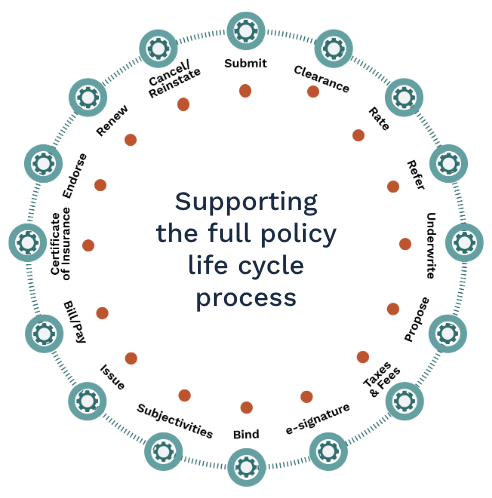A Deep Dive into Insurance Low Code Product Configuration Using Solartis Builder
The insurance industry is in the middle of a significant, technology-driven transformation. Insurance carriers and administrators are seeking agile and scalable solutions that can adapt to evolving needs.
Enter Solartis Insure – a groundbreaking policy administration platform that brings low code configurability to the forefront of insurance product management. At the core of this innovation lies Solartis Builder, an indispensable low code toolkit for insurance product configuration and maintenance.
Benefits of Configurability
Embracing a fully-configurable technology platform unlocks a plethora of benefits for both users and developers. These advantages include:
- Tailored Customization: Configurability empowers users and organizations to mold the technology according to their unique requirements and preferences. This level of customization fosters an enriched user experience and heightens operational efficiency as the technology aligns precisely with needs.
- Adaptive Flexibility: Configurable technology platforms seamlessly adapt to the ever-changing landscape of business requirements, workflows, and user expectations. This flexibility fuels innovation and equips organizations with the agility needed to maintain a competitive edge in dynamic markets.
- Freedom from Vendor Lock-In: The shackles of vendor dependency are broken when a technology platform is fully configurable. System users are liberated from being reliant on the vendor for insurance product changes and from using a single-vendor solution.
- Optimized Workflows: The ability to configure technology to harmonize with specific workflows eliminates convoluted processes. By streamlining procedures to match user needs, productivity soars, and frustration dwindles, fostering a more efficient work environment.
- Seamless Integration: In a world where numerous tools and systems coexist, configurability is paramount. A well-configured platform seamlessly integrates with existing systems, eradicating data silos and enhancing operational efficiency.
- Sustainable Scalability: An organization's growth trajectory is unhindered with a configurable platform. It effortlessly scales to accommodate escalating demands, preventing performance bottlenecks and negating the need for costly and disruptive upgrades.
- Enhanced User Adoption: User acceptance thrives when technology resonates with their preferences and work habits. A configurable platform garners higher user adoption rates by aligning seamlessly with individualized needs.
- Fostering Innovation: Innovation flourishes in an environment where experimentation and customization are nurtured. Configurability empowers developers to explore novel features and functionalities, paving the way for groundbreaking technological advancements.
- Future-Proof Compatibility: As technology evolves, compatibility remains a pivotal concern. Configurable platforms can adapt to new tools and standards, ensuring they stay relevant and effective even in the face of rapid technological change.
- Mitigating Maintenance Costs: The investment in maintaining and adapting a technology platform is optimized through low code configurability. Organizations enjoy reduced long-term costs as the platform adjusts gracefully to evolving needs, obviating the necessity for extensive and expensive overhauls.
The advantages of configurable technology are far-reaching and multifaceted. By empowering users with tailored customization, enabling adaptability and integration, and fostering innovation, configurable platforms position organizations to thrive in an ever-evolving technological landscape while mitigating potential challenges.
Introducing Solartis Insure Cloud
Solartis Insure Cloud stands as a testament to the power of modern cloud-based architecture. This low code fully-configurable, API-centric policy administration platform is built on a microservices foundation, ensuring scalability, security, and adaptability.
Solartis Insure caters to the entire policy administration process for both Property & Casualty (P&C) commercial and personal lines of business, encompassing both admitted and non-admitted insurance products. One of its unique strengths lies in including base insurance product content for personal and commercial lines of business, enabling rapid product configuration and launch.
Key features of Solartis Insure include:
- Effortless Low Code Configuration: Using Solartis Builder, the Solartis platform empowers Solartis and our customers to initially configure, maintain, test, and deploy insurance products that streamline the entire process.
- Seamless API Integration: With over 120 microservices available, Solartis Insure enables API calls from both a Solartis-configured user interface and/or the customer’s technology platform, facilitating smooth integration and orchestration.
- Custom Ecosystem Creation: Insurers can weave a unique insurance ecosystem by seamlessly integrating Solartis' microservices with their APIs and third-party APIs.
Empowerment through Solartis Builder
1. Insurance Product Configuration and Maintenance
The cornerstone of Solartis Insure's flexibility is Solartis Builder. This Low Code toolkit empowers Solartis, and their customers to configure, maintain, and manage insurance products seamlessly. Unlike some legacy applications, Solartis Builder is designed exclusively for the insurance domain.
Solartis Builder capabilities:
- Product Creation: Craft new insurance products from scratch or build upon base products derived from Solartis Base Insurance Product Content. Solartis Builder includes the ISO commercial lines content, allowing users to view, analyze, and manipulate ISO data from a countrywide or state perspective. Carriers configure their exceptions to the pure ISO content in a separate layer, allowing for easy adoption of new ISO versions/circulars.
- Holistic Maintenance: Through Solartis Builder, Solartis customers gain control over all facets of their insurance products, from product versions and deviations to coverages, rate tables, UI/UX pages, documents and their associated forms, underwriting rules, premium calculations and more. All in a Low Code configuration environment.
- Testing and Promotion: Solartis Builder's unified environment accommodates microservice level and full system testing, as well as promotion from “Development” to “Test” to “Live” phases.
- Comprehensive Audit Trail: The toolkit maintains a comprehensive activity log, tracking changes made to insurance products along with the responsible parties and timestamps.
2. Empowering Business Users
Solartis Builder is engineered to put the power of configuration in the hands of business analysts, minimizing the need for technical intervention. Notable tasks that business users can perform include:
- Insurance Product Creation: From the initial setup of the product structure, its attributes, states, and coverages, business analysts can create and maintain insurance products effortlessly.
- Rate Tables and Lookup Tables: Business analysts can configure and maintain rate tables and lookup tables (valid values) with ease. Simply export the tables to Excel, make your changes, and then import the tables back into Solartis Builder.
- Document and Form Management: Solartis Builder empowers business users to configure and maintain all policy documents and their associated forms and form rules.
- Proprietary and Dynamic Forms: Microsoft Word (DocX) is the canvas for creating proprietary forms, seamlessly integrating dynamic product attributes via the Solartis Form Editor Plug-In.
- Underwriting Rules: All underwriting rules (i.e., mandatory, eligibility, underwriting, and referral rules) are easily configured and maintained in the Solartis Builder by a Business Analyst.
- Microservice and JSON Request / Response Creation and Maintenance: Business Analysts have the power in Solartis Builder to create and maintain microservices and their rule tasks. Also, with the help of the Solartis Builder, JSON requests and responses are easily configured to the microservices they support.
- Testing and Promotion: In the Solartis Builder, Business Analysts can test on the microservice level and at the full-system level. In addition, they can promote new versions of their product from “Development” to “Test” to “Live” phases.
3. Future-Forward Innovations
Solartis is committed to continuous innovation, and its roadmap reflects this dedication. Over the next few months, three transformative investments are on the horizon:
- No-Code Configuration: Solartis aims to further empower business users by shifting toward a 100% no-code configuration and maintenance model, accelerating product management.
- Digital Platform 'PlugIns': Offering full support for digital platform 'plug-ins,' Solartis Builder will enable even more seamless integrations, enriching insurers' technological ecosystems.
- Integrated AI Models: Solartis is harnessing the capabilities of artificial intelligence by seamlessly integrating AI models into its platform. This noteworthy technological progress accelerates code generation, bolsters decision-making, and elevates operational efficiency.
The Solartis Insure platform and Solartis Builder collectively redefine insurance product management. With a cloud-native approach, microservices architecture, and a commitment to empowering business users, Solartis is paving the way for innovation in the insurance industry.
As the Solartis platform continues to evolve the insurance landscape will witness the seamless convergence of configurability, efficiency, and technological prowess.
Related Articles
The Secret to Success with ISO ERC™





